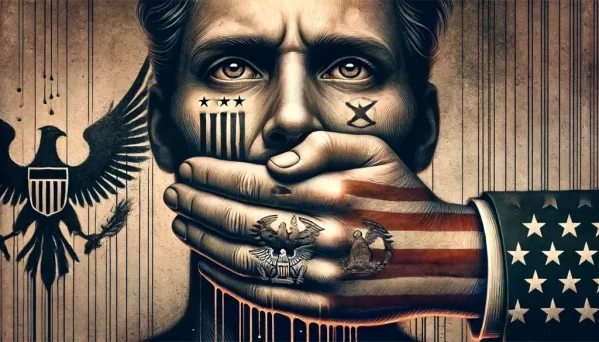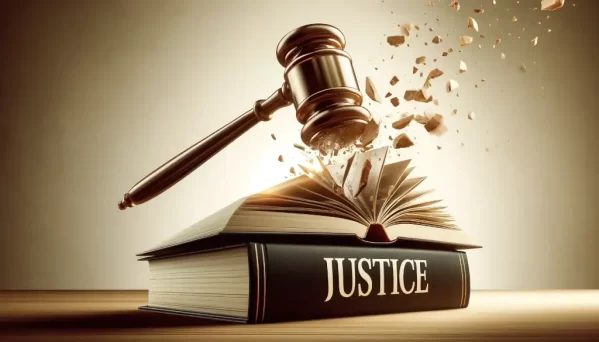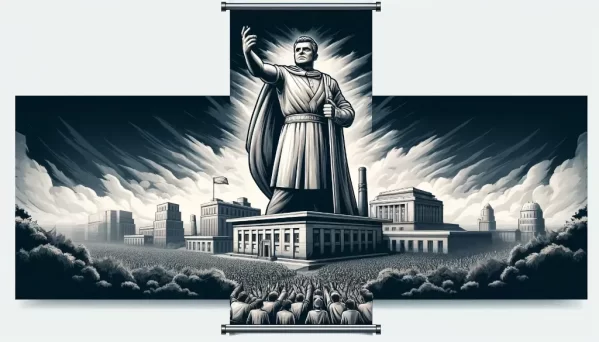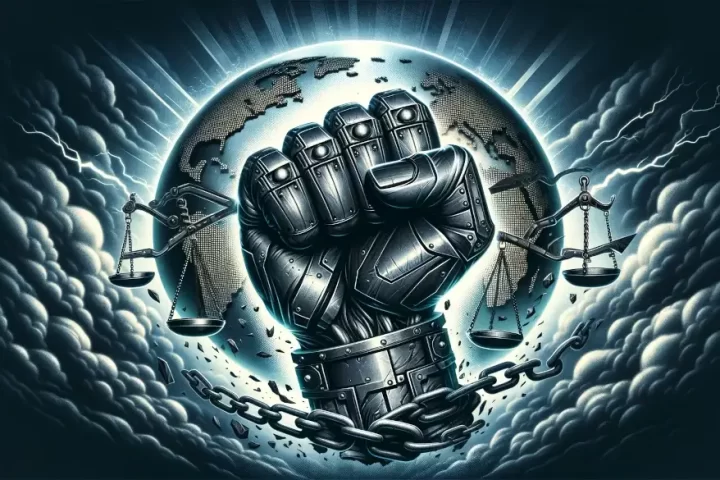Authoritarianism is a political system characterized by centralized control and limited political freedoms. Unlike democratic rule, authoritarian governments restrict political pluralism and civil liberties, often using coercion, propaganda, and surveillance to maintain power. This article explores the nature of authoritarianism, its historical and contemporary examples, and the implications for societies under such governments.
Key Takeaways:
- Concentration of Power:
- Authoritarian rule is characterized by the concentration of power in the hands of a single leader or a small elite group. This centralization allows for swift decision-making but often at the expense of democratic processes and individual freedoms.
- Use of Coercion and Propaganda:
- To maintain control, authoritarian governments frequently employ coercion, including the use of police and military forces to suppress opposition. Additionally, propaganda and media manipulation are used to control public perception and stifle dissent.
- Impact on Society:
- The authoritarian rule significantly impacts the societies they govern by curtailing civil liberties and political pluralism. This suppression of opposition can lead to a climate of fear, reduced innovation, and economic stagnation, as well as widespread human rights abuses.
Table of Contents
Authoritarianism
A political system characterized by centralized control and limited political freedoms has been a dominant form of governance throughout history. Unlike democratic rule, which thrives on political pluralism and civil liberties, authoritarian governments often employ threats, force, propaganda, and surveillance to maintain their grip on power. This article delves into the complexities of authoritarianism, examining its defining characteristics, mechanisms of control, and the profound impacts on the societies under its rule.
“The most effective antidote to authoritarianism is a vibrant civil society that insists on democratic accountability and transparency.”
Diamond, L. (2008). The Spirit of Democracy: The Struggle to Build Free Societies Throughout the World
Understanding Authoritarianism
Requires a comprehensive look at how power is concentrated and maintained. The authoritarian rule can vary widely, from personalist dictatorships to oligarchic structures, but they share common features: suppression of political opposition, restricted individual freedoms, and manipulation of information. By exploring historical examples like Nazi Germany and Francoist Spain, as well as contemporary instances such as Vladimir Putin’s Russia and Saudi Arabia, we can better grasp the dynamics of authoritarian rule and its implications for the future of global governance.
Characteristics of Authoritarian Government
Centralized Power:
In authoritarian rule, power is highly centralized, often resting in the hands of a single leader or a small elite group. This concentration of power enables rapid decision-making without the checks and balances typically found in democratic systems. However, it also means that the whims and interests of the ruling individual or group take precedence over the public’s needs. This can lead to abuses of power and the sidelining of other political actors or institutions.
Limited Political Freedoms:

Authoritarian governments severely limit political freedoms. Political opposition is often banned or heavily restricted, making it difficult or impossible for alternative voices to be heard. Elections, if they occur, are typically neither free nor fair, often manipulated to ensure the ruling party retains power. Civil liberties, such as freedom of speech, assembly, and association, are frequently curtailed, preventing citizens from organizing or expressing dissent.
Use of Threats and Force:
Coercion and repression are common tools in authoritarian power. Governments employ force, intimidation, and imprisonment to control opposition and maintain their grip on power. State security services, including police and military forces, are often used to monitor, harass, and eliminate perceived threats to the system of government. This creates a climate of fear, discouraging citizens from challenging the status quo.
Control Over Media:
Control over media is a hallmark of authoritarian rulers. The state often controls or heavily censors media outlets to prevent dissent and shape public perception. Independent journalism is stifled, and propaganda is used to promote the state’s narrative. By controlling the flow of information, authoritarian governments can manipulate public opinion, suppress opposition, and maintain their authority.
Manipulation of Law:

In authoritarian states, the legal system is frequently manipulated to serve the interests of the ruling party. Laws are selectively enforced, and judicial independence is undermined. Courts may be used as tools to persecute political opponents and legitimize the government’s actions. Legal frameworks are often designed or interpreted in ways that reinforce the power of the ruling elite, ensuring their continued dominance and suppressing challenges to their authority.
Authoritarian governments come in various forms, each with unique characteristics and methods of maintaining power.
What are the Three Types of Authoritarian Governments:
Personalist Dictatorships

In personalist dictatorships, power is concentrated in the hands of a single leader who often rules through charisma, patronage, and repression. These leaders typically do not rely on a party or military support but instead, maintain control through a network of loyalists and personal alliances. Personalist dictatorships are characterized by the leader’s dominance over the political system and often involve significant cults of personality.
Examples:
- North Korea under Kim Jong-un
- Iraq under Saddam Hussein
Military Regimes
Military governments, also known as military juntas, are authoritarian governments where the military controls the political power. They often come to power through coups d’état and justify their rule as a necessity to restore order or defend the nation. The military leaders may or may not transition to civilian rule but typically maintain strict control over political and social life, often suspending constitutional governance and limiting civil liberties.
Examples:
- Myanmar (Burma) under various military leaders
- Egypt under General Abdel Fattah el-Sisi
Single-Party States
Single-party states are authoritarian states where a single political party controls the government, and other political parties are either banned or allowed only a nominal existence. These governments are often characterized by a highly centralized and hierarchical party structure that dominates the political landscape, controlling both government and civil society. The ruling party uses mechanisms such as propaganda, patronage, and sometimes coercion to maintain its dominance and suppress opposition.
Examples:
- China under the Chinese Communist Party
- Cuba under the Communist Party of Cuba
These three types of authoritarian governments illustrate the diverse ways in which political power can be concentrated and maintained in non-democratic ways. Understanding these variations helps to contextualize the different strategies and impacts of authoritarian rule globally.
Mechanisms of Control in the Authoritarian States
Threats and Force
Authoritarians frequently employ threats and force to maintain control. This includes the use of police and military forces to suppress protests, imprison political opponents, and intimidate citizens. For example, in contemporary Russia, the government has used legal mechanisms and law enforcement to stifle dissent and maintain President Vladimir Putin’s grip on power.
Propaganda and Censorship
Control over information is a critical tool used by authoritarian states. Propaganda is used to promote the government’s agenda and ideology, while censorship prevents the dissemination of opposing views. In China, the government controls internet access and censors content to maintain social stability and political control.
Surveillance and Intelligence Gathering

Surveillance is another key mechanism, with authoritarian governments using advanced technologies to monitor their citizens. The Stasi in East Germany was notorious for its extensive surveillance network, which infiltrated almost every aspect of daily life to root out dissent and maintain state control.
Historical Examples of Authoritarian Rules
Nazi Germany
Adolf Hitler in Nazi Germany is a prime example of authoritarian rule. While it exhibited totalitarian characteristics, such as pervasive propaganda and a cult of personality, its primary focus was on maintaining political control and suppressing opposition through coercion and violence.
Francoist Spain
Under Francisco Franco, Spain experienced a period of authoritarian rule characterized by political repression, censorship, and the suppression of regional autonomy. Franco maintained power through a combination of military force, propaganda, and alliances with conservative elements of Spanish society.
Current Examples of Authoritarian States
Vladimir Putin’s Russia
Russia under Vladimir Putin exhibits many characteristics of an authoritarian power. Political opposition is suppressed through legal means and intimidation, the media is state-controlled, and there is extensive surveillance of political activists and critics.
Saudi Arabia
Saudi Arabia’s monarchy is another contemporary example of authoritarianism. The government maintains strict control over political expression, media, and public discourse while enforcing conservative social norms through legal and religious means.
Impact of Authoritarianism on Society
Authoritarian governments significantly impact the societies they govern. Civil liberties, such as freedom of speech, assembly, and the press, are often curtailed. Political pluralism is limited, and citizens may face persecution for expressing dissenting views. The suppression of opposition can lead to a lack of innovation and economic stagnation, as fear stifles creativity and entrepreneurship.
Defining Autocracy and its Relation to Authoritarianism
An autocracy is a system of government in which a single person holds absolute power. Unlike democracies, autocracies do not allow for political pluralism or citizen participation in decision-making processes. Authoritarian power can sometimes be autocracies, but not all authoritarian states are autocracies. While an autocracy focuses on the absolute power of one individual, authoritarianism can involve a small group or a single leader with concentrated power.
Differentiating Between Authoritarianism and Totalitarianism
While both authoritarianism and totalitarianism involve centralized control and limited political freedoms, there are key differences. Totalitarian governments extend control into nearly every aspect of public and private life, often employing pervasive propaganda and indoctrination to maintain power. Authoritarian control, on the other hand, may allow some degree of personal autonomy and economic freedom as long as it does not threaten political control.
Economic Freedom in Authoritarian Governments
Some authoritarian governments allow economic freedom as long as it does not threaten political control. For example, China’s government permits significant economic autonomy while maintaining strict political control. This approach can lead to economic growth and development, but it also creates an environment where political dissent is not tolerated.
The Use of Propaganda in Authoritarian Rule
Authoritarian control uses propaganda to shape public perception and promote their agendas. This includes state-controlled media, educational indoctrination, and the suppression of dissenting views to maintain a positive image of the state. Propaganda is a powerful tool for maintaining control and ensuring the governements stability.
Conclusion
Understanding authoritarianism is crucial for recognizing the signs and mechanisms of these systems of government. Authoritarian governments use centralized power, coercion, propaganda, and surveillance to maintain control, often at the expense of political freedoms and civil liberties. By examining historical and contemporary examples, we can gain insights into the dynamics of authoritarian rule and its impact on society.
Citations and External References
- Academic Articles
- Historical Examples
- Payne, S. G. (2000). Franco and Hitler: Spain, Germany, and World War II. New Haven: Yale University Press.
- Current Events
- Educational Resources
The Use of External Resources
The academic articles and historical examples cited are from well-regarded scholarly sources and reputable history books, ensuring a high level of confidence in their accuracy and reliability. The current events references are from reputable news organizations known for their thorough reporting, providing credible contemporary examples of authoritarian regimes. The educational resources come from established and trusted encyclopedias, offering reliable background information for readers.
